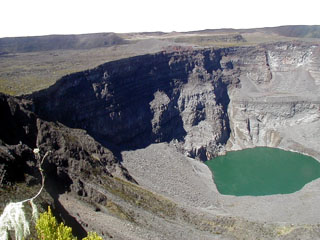Report on Karthala (Union of the Comoros) — 10 January-16 January 2007
Smithsonian Institution / US Geological Survey
Weekly Volcanic Activity Report, 10 January-16 January 2007
Managing Editor: Sally Sennert.
Please cite this report as:
Global Volcanism Program, 2007. Report on Karthala (Union of the Comoros) (Sennert, S, ed.). Weekly Volcanic Activity Report, 10 January-16 January 2007. Smithsonian Institution and US Geological Survey.
Karthala
Union of the Comoros
11.7658°S, 43.3639°E; summit elev. 2350 m
All times are local (unless otherwise noted)
According to news articles, scientists from the Karthala Volcano Observatory reported that an eruption occurred at Karthala during the evening of 12 January. Residents reported incandescence at the summit and strong fumes. Several strong tremors and earthquakes occasionally larger than M 4 were registered on 13 January. A lava lake that formed in the volcano's crater was seen during aerial observations on 15 January.
Geological Summary. The southernmost and largest of the two shield volcanoes forming Grand Comore Island (also known as Ngazidja Island), Karthala has two overlapping 3-4 km summit calderas generated by repeated collapse. Elongated rift zones extend NNW and SE from the summit of the basaltic shield, which has an asymmetrical profile that is steeper to the S. The lower SE rift zone forms the Massif du Badjini, a peninsula at the SE tip of the island. More than twenty eruptions have been recorded since the 19th century from the summit caldera and vents on the N and S flanks, producing many lava flows that reached the sea on both sides of the island. An 1860 CE lava flow from the summit caldera traveled ~13 km to the NW, reaching the W coast to the N of the capital city of Moroni.
Sources: UN Office for the Coordination of Humanitarian Affairs (OCHA), Reuters

